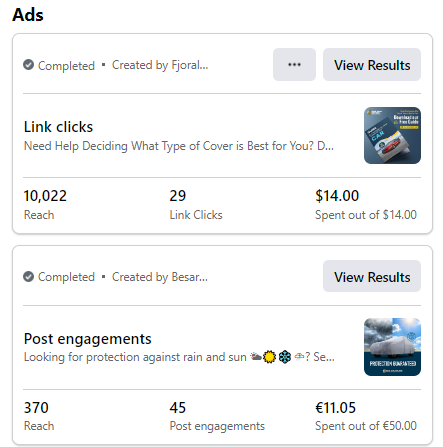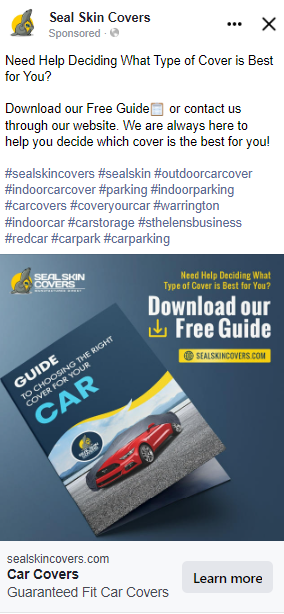Facebook ads that you see in your news feed can sometimes be annoying. We’ve all seen ads like that – they’re not interesting to us, or perhaps they’re not relevant for what we’re looking to buy at the moment. However, when done right, these ads are very effective, as they help business owners introduce their products or services to potential buyers.
If you are a business owner, Facebook ads can work wonders for your business. There are about 1.9 billion daily active users on this platform, and when you create a properly targeted ad, the chances of it converting into a sale skyrocket.
Facebook ads can be a boon for your business, as they can build a massive audience for your brand and generate a good return on investment (ROI). Here are some benefits of Facebook ads:
- Ads have a much bigger reach compared to what you might achieve through organic posts.
- You can remarket to people who have interacted with you and who are already aware of your brand.
- You can find new leads who are more likely to purchase from you.
- Facebook lets you build customizable ads that will reflect your brand and target audience, allowing you to better control the ad you create.
Facebook brand awareness ads can increase the recall value of your brand amongst your target audience. You may have already tried to scale these campaigns, but it may not have worked out. Scaling Facebook ads isn’t necessarily as simple as pouring more money into the program – that’s how you can wind up with people annoyed at seeing your ads, since they aren’t relevant. Firstly, let’s try to understand what it means to scale Facebook ads.
Scaling Facebook Ads: What You Need to Know
Scaling Facebook ads can be intimidating and challenging, especially if you are not familiar with the process. This process is all about increasing your ad budget to reach a wider audience while maintaining a high return on ad spend (ROAS). There can be many reasons why your Facebook ads are not scaling well. Here are some of them:
- You are running many ad sets simultaneously. Running too many ads will make it hard to focus on the right creative and will overcomplicate things for your audience. You will not be able to determine which creatives work and which don’t due to the difficulty in identifying your best-performing ad sets.
- You are not following Facebook’s recommended account simplification methodology. Facebook ad campaigns contain one or more ad sets, and ad sets contain one or more ads. You will have to choose an ad objective to define your goals. You can only choose one ad objective for a campaign. This helps improve the efficiency of your ads.
- Your product may not be in demand. Sometimes, there could be nothing wrong with your scaling steps. It’s just that your product doesn’t fit anything other than a niche in the market, and people outside that niche are not interested in buying it. You should take a step back and analyze a couple of things in such situations. You may have not gotten your pricing strategy, competitive analysis, or demographics right.
8 Tips on How to Scale Facebook Brand Awareness Campaigns
Here are a few ways you can plan your Facebook brand awareness campaigns to scale leads.
#1. Identify the right ads to scale based on their performance metrics

- By running many ads, you may end up spending more of your budget by increasing your ad spend for the wrong ad.
- You may not be able to optimize performance, resulting in audience overlap and increased time in the learning phase.
- Analyze the overall campaign performance, audience insights, ROAS, and so on, and scale an ad based on the performance metrics if it looks like a winning ad.
#2. Develop buyer personas to determine buyer motivations
- It is important to understand the likes, dislikes, and motivations of your potential customers. For this, you should first have a clear idea about the gender, age range, and other demographics of your existing customers.
- Facebook Insights can provide you with important details about your existing customers and the ones who have engaged with your brand. This type of information will help you understand their motivations and what is driving their purchases. It can also help you determine the most fertile ground to expand your Facebook ad campaigns. (More on this in the next point.)
- Once you have discovered the motivations of your current customers, you will be able to make assumptions about your target audience and convert visitors into customers through your Facebook ad campaign.
#3. Build a lookalike audience to expand your reach

- You must be wondering what a lookalike audience is. To understand that, you must first know what a custom audience is. You can create a custom audience based on your existing customers who have interacted with your website or social media platforms. It allows you to reach those who already have a relationship with your business.
- Once you have built your custom audience, you can create a lookalike audience that tells Facebook to find people similar to your buyer personas and your current customer base. To put it simply, it tells Facebook to find people similar to the people in your custom audience.
- Lookalike audiences can be determined based on your customer data, custom audiences, page likes, users who performed a specific action on Facebook, and so on. Based on these factors, Facebook identifies parallel users based on similarities and creates a lookalike audience.
- Lookalike audiences ensure that your Facebook advertising campaigns are performing well and reaching new potential customer segments.
#4. Retarget cart abandonment activity
- Through retargeting, you are trying to reach out to those who had the intention to purchase your product but didn’t do so. This can be for many reasons; it may have not been the right time for them or maybe they needed more convincing. Such customers are extremely valuable, since they’re not only familiar with your brand but also have high buying intent.
- Users who abandon their shopping attempt can be classified into three segments; (1) Users who visit your product pages but not the cart. (2) Users who click the cart pages but don’t go through checkout. (3) Users who click the checkout pages but don’t go to the thank you page.
- Your cart abandonment Facebook campaigns should be aimed toward one of these three segments. You can also personalize your conversion chances by personalizing your ads to the exact pages the customers visited. Combining cart abandonment segments with dynamic Facebook ads can produce brilliant results.
#5. Create strong ad content that has a wide appeal

- Your ad content should be inspiring and resonate emotionally with your target audience.
- The goal of brand awareness ads is to develop some sort of connection with your audience and give them a feel for what you stand for.
- By creating an appealing ad that widely resonates, you increase the chances of your Facebook marketing campaign being shared with others. If your ad campaign has a universal message, it will impact more people.
- If you feel that you do not have an eye for appealing design, text, or video, you can always reach out to professionals. Partner with great content creators for an even more engaging message.
- Facebook Branded Content ads (BCA) can help you achieve your goals quickly.
#6. Exploit mobile ads for a larger reach

- According to research done by Statista, there are about six billion smartphone users in the world today, which is about 83% of the world’s population.
- These are staggering numbers, and unsurprisingly, more people use smartphones to browse the internet than they use desktops or laptops.
- Consumers spend the majority of their time on five non-native apps they’ve installed from the app store while using smartphones, one of which is Facebook. Therefore, it is a no-brainer to use mobile Facebook ads to reach a wider audience as Facebook is a great place to grab the attention of people who are browsing for a few minutes.
- Your content should be concise and to the point and must include attention-grabbing images and videos, along with a compelling call-to-action (CTA).
- To better track mobile Facebook ads performance, use marketing analytics solutions like Improvado to run a marketing attribution model with cross-channel identity recognition.
#7. Find your competitors’ targets
Everything is a competition in the world of business, and while running your own business, it is quite natural that you would want to know what you are up against. You can easily find out what your competitor’s Facebook ads look like thanks to Facebook’s updated privacy policy.
Once you have gathered all the necessary data from your competitor’s Facebook page, you should analyze them and identify a couple of important things.
- Every business is unique at some level, and so you should identify where you and your competitors are different, as spotting the difference gives you an edge in creating your own Facebook ads.
- Once you have identified the difference, you need to create ads that capitalize on the differences. Do not say that you will be offering the same thing at a cheaper rate and faster. Instead, specify how you will be solving the same problem in a different way.
#8. Tap into affinity brand audiences
- Affinity audience refers to a group of potential customers who are not just interested in what you have to offer but also share similar interests.
- If your company manufactures and sells eco-friendly vehicles, your affinity audience may contain both people who love cars and also those who love the environment. Such groups with both qualities included are more likely to buy your product than either group individually.
- Affinity targeting identifies the ideal affinities that align with your product or service based on a feeling of closeness and understanding, thereby extending your reach from your current lists.
Final Thoughts
These are some useful strategies you can use to scale your Facebook ad campaigns and generate a better return on investment (ROI) on your ads. Remember, Facebook ad campaigns can be implemented effectively only if you find out who your target audience is and what motivates them to make a purchase. Once you have identified that, you should give priority to building relationships with your potential customers and then focus on conversions.
.png)



.png)
